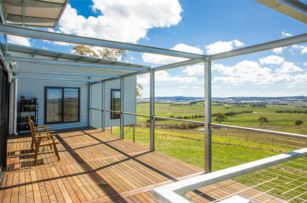Passive solar architecture is a sustainable design principal, that takes advantage of the climate to maintain a comfortable temperature in the home all year round. Windows, walls and floors are made to collect, store and distribute solar energy in the form of heat in winter and disperse solar heat in summer. Passive design reduces (and sometimes eliminates the need for you to use heating or cooling devices such as air-conditioners, gas heaters or other forms of electrical devices to control the temperature.
At some point during the delivery of your new home to the site we will need to get the modules off the truck and onto the newly installed foundations. Where ever possible we will try to transfer the modules from the truck directly onto the stumps but in some cases the only possible way is to use a crane. Your site will be assessed individually and the access and modules delivery system determined.
One of the important first steps in the construction of your new home is organising a soil test so the building foundations can be designed and certified. The soil test will give the soil a classification based on the NCC. Many of the sites where we have built have had a S or M rating. These classifications usually present no problems for the Surefoot stumping system that we often use.
It is a running joke at Prominda that our sales staff say all sites are flat and access is easy. However, once site levels are taken - it turns out almost all sites have a slope! The good news is, in most cases a little slope is helpful as it makes it easy to determine where rainwater or septic tanks should best be placed. Remember that water - and other things - like to flow downhill
If you’re planning to build a home or purchase a new property, you’ll soon come across the term “BAL” (Bushfire Attack Level). It’s important to understand BAL ratings because they can affect your building costs and overall budget - especially if your property has a high risk level. Let’s take a look at BAL classifications and what factors can affect where your property rates.
The land we build on has a long history. Plants, animals and other organisms - many too small for the eye to see - all depend on that land for survival, and in turn, the health of our land depends on them. Biodiversity is the measure of the variety of these organisms, each of which are part of a delicate balancing act happening all around us at all times.
You have your block - but what comes next?
An architect? A draftsman? An engineer? A geotechnician? A planning consultant? An ecological consultant? A bushfire consultant? A builder?
Even after securing your dream patch of land, designing and building the house you want within your budget can seem like an overwhelming task. At Prominda, we’ve streamlined this process to help you bypass the maze of professionals and skip straight to the good part - building your home.
Westerly winds spring up at the most inopportune time, such as when an 11-tonne section of a new home was gently raised on the end of a huge crane near Gundaroo on Monday afternoon.
Lesley Livingstone’s master bedroom was hoisted from the back of a semi-trailer parked between a 137,000-litre water tank, and shed and stables on the other, with millimetres to spare.
According to the "tried and true locals", winter 2016 was the wettest and windiest in more than 50 years at Breadalbane, NSW.
Though we all love the colours, look, and feel of Colourbond on your Prominda home, there are many other options available when choosing your external cladding.
Building a new home is not easy and can be expensive. From finding land to designing the house and paying the unpredictable costs of labour...
Whether it’s for keeping cool in summer or warm in winter, it’s hard to go past installing double glazed windows in your home.
Last Thursday we published a feature in The Land about the Goodens and their new Prominda home.

















Meet our team with th new video "About us".